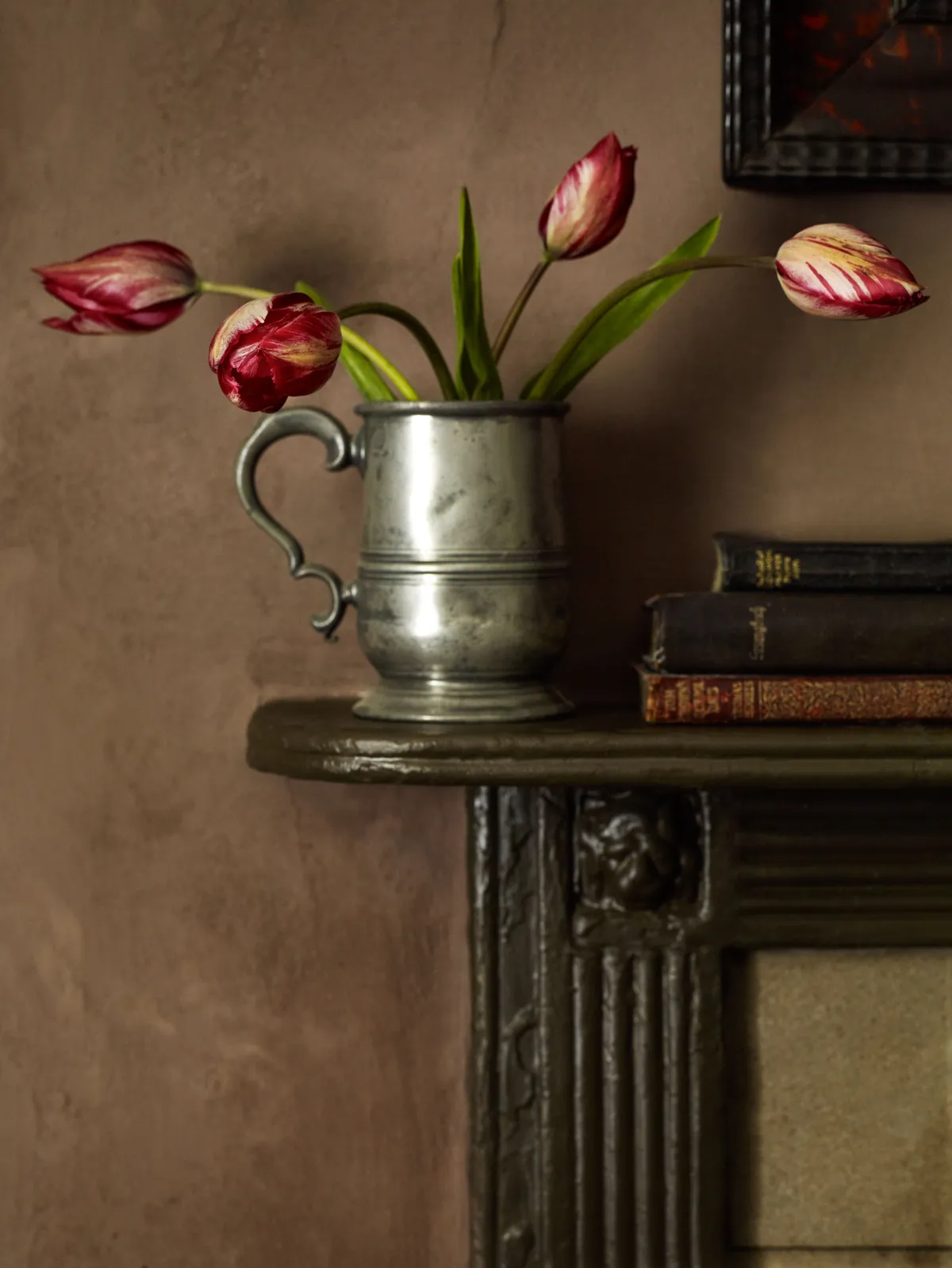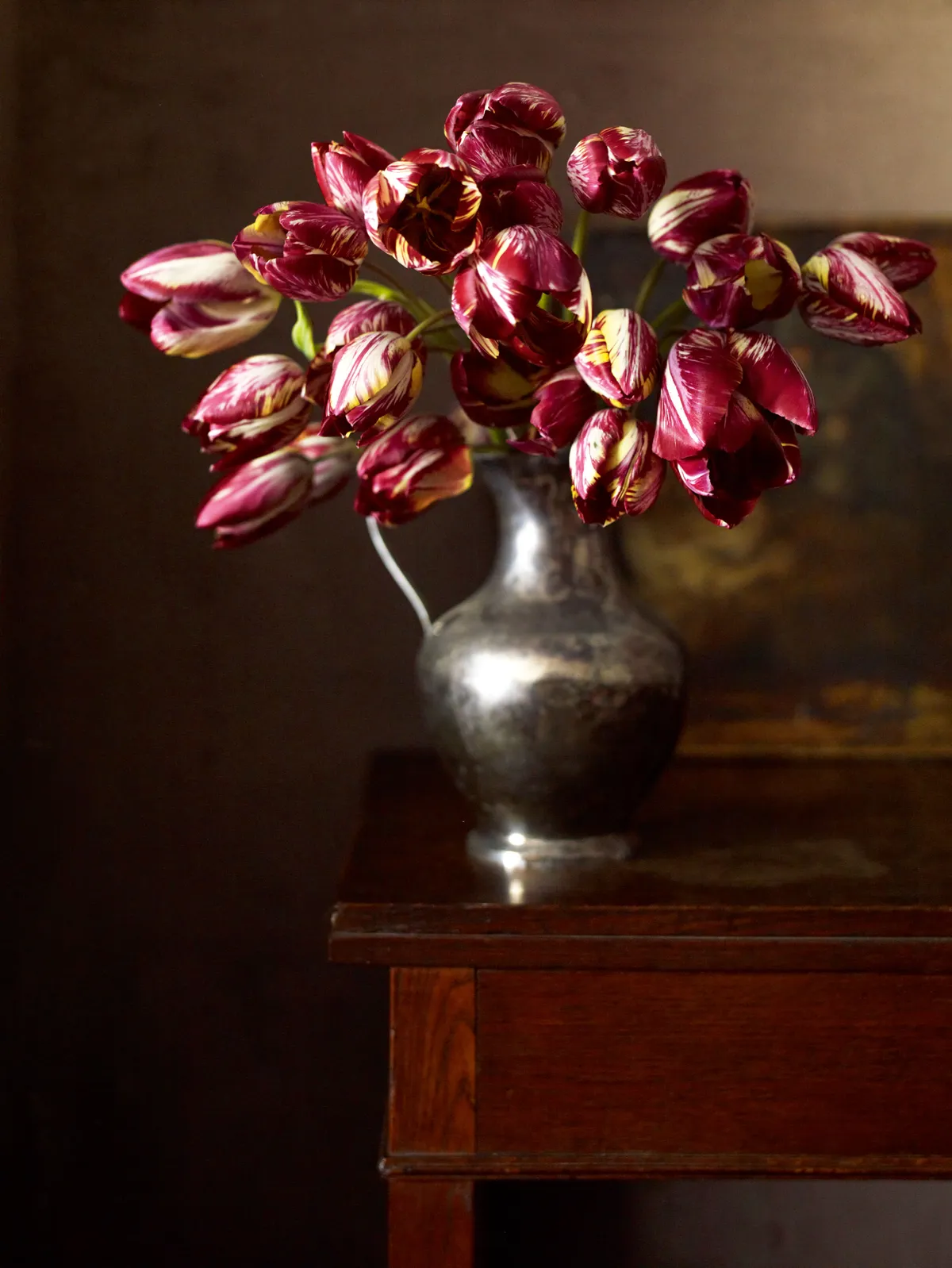My passion for these rare, historic tulips began when I started to grow Tulipa ‘The Lizard’ in the courtyard garden at my home Allt-y-bela, just by the front door. It’s a special moment when they appear in May, and they have multiplied, happy in the gritty conditions created to counteract the wet Welsh weather. Guests cannot pass without commenting. They are exquisite curiosities, and led me to seek out more rarities, my criteria being personal taste rather than any specific category of tulip.
Read about 21 of the best tulips to grow, in the walled garden at Belcombe Court, designed by Arne Maynard.

We gave over a section of our kitchen garden to trialling rows of Broken and Breeder tulips, which came up, like a perfect sweet shop. It was my ultimate pleasure to harvest them for the house and arrange them in the fashion of 17th-century Dutch floral still lifes. To catch a glimpse of these beautiful tulips through a door or window, is a heart-stopping way to travel through time.

Broken or rectified tulips date back to the 17th century, when these flamed and feathered tulips changed hands for incredible prices across the Netherlands, leading to the ‘tulip mania’ that caused a speculative economic bubble in the 1630s. Today we know that the feathering is caused by a tulip breaking virus, but at the time it must have seemed like some kind of alchemy when the blooms began to show fine, contrasting flushes and tinged edges.
Today some of the most perfect examples of these rare tulips are grown by members of the Wakefield and North of England Tulip Society. Their tulips aren’t for sale, but in the true tradition of English Florists’ Societies, members cultivate and share bulbs among themselves. Some have been given to Hortus Bulborum in the Netherlands, which has increased stocks sufficiently to enable a few companies to offer a limited number for sale. It’s these commercially produced ones I have grown, and although they’d never make the standards of the Society’s show bench, they are still glorious and timeless beauties. See below for more examples.
Tulip ‘Absalon’ (1780), Tulip ‘Insulinde’ (1914), Tulip ‘Gloria Nigrorum’ (1837)

Tulip ‘Absalon’ (furthest left) is moody with swirls of mahogany over a barely glimpsed yellow base, whereas Tulip ‘Insulinde’ (centre) is soft and marbled with grape. Tulip ‘Gloria Nigrorum’ (back, top left) is strikingly etched at the edges and marked with a central rib in the darkest of violets over ivory.
Tulip ‘Bridesmaid’ (1900)

I love the elegance of the long, slender Tulip ‘Bridesmaid’ (also known as Tulip ‘Maid of Holland’). With fine, cherry-red feathering over white, it has a restraint and sophistication, more like an elegant, tailored suit than an attention-grabbing party outfit.
Tulip ‘Columbine’ (1920)

The markings of my Tulip ‘Columbine’ varied in their strength, but were consistent in their exquisite, imperial purple beauty. They open out like a cup to reveal black (pollen-bearing) anthers, striking in their contrast to the white ground.
Tulip ‘Royal Sovereign’ (1809) and Tulip ‘Dom Pedro’ (1911)

For sheer exhilarating extravagance, Tulip ‘Royal Sovereign’ with its fine, feathered edges is hard to beat. The mahogany red on a golden yellow ground is tempered here by the pairing with the wonderful solid velvety red-brown of Tulip ‘Dom Pedro’.
Tulip ‘The Lizard’ (1903)

Like the rich end papers of a treasured old book, Tulip ‘The Lizard’ is a ravishing, swirling mix of deep lilac and dark reddish rose on a creamy yellow and white base. A particular favourite of mine, I eagerly await its return every May.
Tulip ‘Mabel’ (1836)

The clarity of the extraordinary, finely flamed and sometimes feathered deep-rose markings on a clear white ground give Tulip ‘Mabel’ the graphic qualities reminiscent of many of the tulips in the Dutch Master paintings.
Tulip ‘Mrs Harold I Pratt’ (1926), Tulip ‘Lord Stanley’ (1880), Tulip ‘Prince of Wales’ (1863), Tulip ‘Mahogany King’ (1905) and Tulip ‘La Joyeuse’ (1863)

These rare and subtle ‘Breeder’ tulips shown together, really demonstrate their pedigree – nothing garish, but a wonderful depth of colour. Middle top: the pale Rose Madder Tulip ‘Mrs Harold I Pratt’; centre: the dark- red Tulip ‘Lord Stanley’; from bottom left to top left: dark, purple-brown Tulip ’Prince of Wales’, reddish brown Tulip ‘Mahogany King’ and lilac pink, pale at the edges Tulip‘La Joyeuse’.
Cultivation
1
Lift tulips after foliage has died down
Because of our damp summers, it is recommended that tulips are lifted and replanted in autumn.
2
Well drained soil
Make sure the soil is well-drained and bulbs planted 10-15cm deep
3
Moisture and heat
In the wild, most tulips grow in mountainous areas where the melting snow provides plentiful moisture in spring, followed by several months of baking at high temperatures, which gives some indication of the conditions tulips need.
Suppliers
- Jacques Amand 020 8420 7110, jacquesamandintl.com
Peter C Nijssen pcnijssen.nl - Societies Hortus Bulborum Foundation is dedicated
to preserving historic tulip cultivars. - The Wakefield and North of England Tulip Society North Yorkshire HG2 8AA. tulipsociety.co.uk





